Combination of Niraparib, Cisplatin and Twist Knockdown in Cisplatin-Resistant Ovarian Cancer Cells Potentially Enhances Synthetic Lethality through ER-Stress Mediated Mitochondrial Apoptosis Pathway
- PMID: 33920140
- PMCID: PMC8070209
- DOI: 10.3390/ijms22083916
Combination of Niraparib, Cisplatin and Twist Knockdown in Cisplatin-Resistant Ovarian Cancer Cells Potentially Enhances Synthetic Lethality through ER-Stress Mediated Mitochondrial Apoptosis Pathway
Abstract
Poly (ADP-ribose) polymerase 1 inhibitors (PARPi) are used to treat recurrent ovarian cancer (OC) patients due to greater survival benefits and minimal side effects, especially in those patients with complete or partial response to platinum-based chemotherapy. However, acquired resistance of platinum-based chemotherapy leads to the limited efficacy of PARPi monotherapy in most patients. Twist is recognized as a possible oncogene and contributes to acquired cisplatin resistance in OC cells. In this study, we show how Twist knockdown cisplatin-resistant (CisR) OC cells blocked DNA damage response (DDR) to sensitize these cells to a concurrent treatment of cisplatin as a platinum-based chemotherapy agent and niraparib as a PARPi on in vitro two-dimensional (2D) and three-dimensional (3D) cell culture. To investigate the lethality of PARPi and cisplatin on Twist knockdown CisR OC cells, two CisR cell lines (OV90 and SKOV3) were established using step-wise dose escalation method. In addition, in vitro 3D spheroidal cell model was generated using modified hanging drop and hydrogel scaffolds techniques on poly-2-hydroxylethly methacrylate (poly-HEMA) coated plates. Twist expression was strongly correlated with the expression of DDR proteins, PARP1 and XRCC1 and overexpression of both proteins was associated with cisplatin resistance in OC cells. Moreover, combination of cisplatin (Cis) and niraparib (Nira) produced lethality on Twist-knockdown CisR OC cells, according to combination index (CI). We found that Cis alone, Nira alone, or a combination of Cis+Nira therapy increased cell death by suppressing DDR proteins in 2D monolayer cell culture. Notably, the combination of Nira and Cis was considerably effective against 3D-cultures of Twist knockdown CisR OC cells in which Endoplasmic reticulum (ER) stress is upregulated, leading to initiation of mitochondrial-mediated cell death. In addition, immunohistochemically, Cis alone, Nira alone or Cis+Nira showed lower ki-67 (cell proliferative marker) expression and higher cleaved caspase-3 (apoptotic marker) immuno-reactivity. Hence, lethality of PARPi with the combination of Cis on Twist knockdown CisR OC cells may provide an effective way to expand the therapeutic potential to overcome platinum-based chemotherapy resistance and PARPi cross resistance in OC.
Keywords: PARPi; Twist; cisplatin; cisplatin resistance; lethality; niraparib; ovarian cancer.
Conflict of interest statement
The authors declare no conflict of interest.
Figures


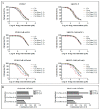
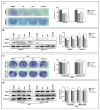

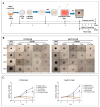
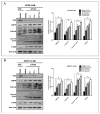

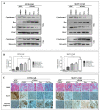


Similar articles
-
Establishment of Acquired Cisplatin Resistance in Ovarian Cancer Cell Lines Characterized by Enriched Metastatic Properties with Increased Twist Expression.Int J Mol Sci. 2020 Oct 15;21(20):7613. doi: 10.3390/ijms21207613. Int J Mol Sci. 2020. PMID: 33076245 Free PMC article.
-
ARL6IP5 reduces cisplatin-resistance by suppressing DNA repair and promoting apoptosis pathways in ovarian carcinoma.Cell Death Dis. 2022 Mar 15;13(3):239. doi: 10.1038/s41419-022-04568-4. Cell Death Dis. 2022. PMID: 35293383 Free PMC article.
-
Activation of Wnt signaling promotes olaparib resistant ovarian cancer.Mol Carcinog. 2019 Oct;58(10):1770-1782. doi: 10.1002/mc.23064. Epub 2019 Jun 10. Mol Carcinog. 2019. PMID: 31219654 Free PMC article.
-
Emerging drugs for the treatment of ovarian cancer: a focused review of PARP inhibitors.Expert Opin Emerg Drugs. 2020 Jun;25(2):165-188. doi: 10.1080/14728214.2020.1773791. Epub 2020 Jun 22. Expert Opin Emerg Drugs. 2020. PMID: 32569489 Review.
-
[Abnormalities of DNA repair and gynecological cancers].Bull Cancer. 2017 Nov;104(11):971-980. doi: 10.1016/j.bulcan.2017.09.007. Epub 2017 Oct 18. Bull Cancer. 2017. PMID: 29054544 Review. French.
Cited by
-
Targeting endoplasmic reticulum stress signaling in ovarian cancer therapy.Cancer Biol Med. 2023 Oct 10;20(10):748-64. doi: 10.20892/j.issn.2095-3941.2023.0232. Cancer Biol Med. 2023. PMID: 37817482 Free PMC article. Review.
-
Mechanistic Insights into Autophagy-Dependent Cell Death (ADCD): A Novel Avenue for Cancer Therapy.Cells. 2025 Jul 13;14(14):1072. doi: 10.3390/cells14141072. Cells. 2025. PMID: 40710325 Free PMC article. Review.
-
Endoplasmic reticulum stress response pathway-mediated cell death in ovarian cancer.Front Oncol. 2024 Sep 10;14:1446552. doi: 10.3389/fonc.2024.1446552. eCollection 2024. Front Oncol. 2024. PMID: 39319052 Free PMC article. Review.
-
Role of EMT in the DNA damage response, double-strand break repair pathway choice and its implications in cancer treatment.Cancer Sci. 2022 Jul;113(7):2214-2223. doi: 10.1111/cas.15389. Epub 2022 May 24. Cancer Sci. 2022. PMID: 35534984 Free PMC article. Review.
-
Beyond 2D cell cultures: how 3D models are changing the in vitro study of ovarian cancer and how to make the most of them.PeerJ. 2024 Aug 29;12:e17603. doi: 10.7717/peerj.17603. eCollection 2024. PeerJ. 2024. PMID: 39221267 Free PMC article. Review.
References
MeSH terms
Substances
Grants and funding
LinkOut - more resources
Full Text Sources
Other Literature Sources
Medical
Research Materials
Miscellaneous

